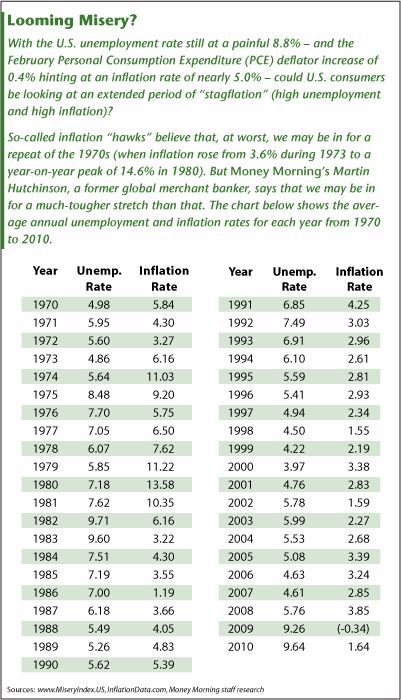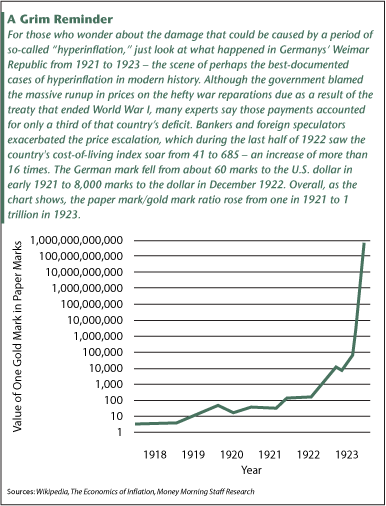Pretty much everyone but U.S. Federal Reserve Chairman Ben S. Bernanke sees that inflation is returning: After all, even Bernanke's favorite inflation measure, the Personal Consumption Expenditure (PCE) deflator, was up 0.4% in February - which hints at an annualized inflation rate of almost 5%.
What folks don't see, however, is just how bad inflation will get.
Look Beyond the Numbers
At first glance, the most recent inflation statistics are disquieting, but no more.
Bernanke would tell us that "core" consumer price inflation, excluding food and energy, rose at only 1.2% in the last six months. Overall consumer price inflation rose 0.4% in February, and has risen at an annual rate of 3.7% in the last six months.
Even Bernanke's favorite indicator - the price index for Personal Consumption Expenditures - was up 2.7% over the last six months, suggesting that inflation is indeed stirring.
The inflation "hawks" - who want Bernanke to stop buying U.S. Treasury bonds and raise interest rates - believe that the worst we'll see is a reprise of the stagflation-ridden 1970s, wheninflation rose from 3.6% in 1973 to a year-over-year peak of 14.6% in 1980.
The reality is that the United States does not have the same policy mix today as it did in the 1970s. So there's no reason to expect the same gradual inflationary escalation, which was ultimately fixed by then-Fed Chairman Paul A. Volcker's painful - but not-too-damaging - tight-money policy.

This time around, things could get much worse.
Indeed, when you look at the producer-price (PPI) and import-price indices, the picture is more alarming. The PPI has increased at a 10.0% annual rate in the last six months, while U.S. import prices have increased at a 14.5% annual clip.
In short, these few indicators - which may provide a more-accurate advance warning than the consumer price index (CPI) itself - show inflation is already running at peak 1970s levels.
Granted, six months is a short period to review. And those numbers may reverse course and decline in the near future.
But don't bet on it.
That 70s 'Show'
If we take an honest look at fiscal and monetary policy, it's pretty clear that the odds favor an advance in inflationary statistics - and not a retreat. This will spark an inflation advance in import prices, consumer prices and, eventually, even Bernanke's beloved core-CPI and PCE indicators. This advance will take inflation up to its 1970s peak - and then beyond.
Even though monetary policy was expansionary and governments ran budget deficits in the 1970s, in neither case was there anything like we have today. Interest rates have been below the rate of inflation for 30 months; as inflation takes off, that gap will widen.
Then there's the budget deficit. In terms of gross domestic product (GDP), the deficit is almost double the previous all-time peacetime peak, reached in 1983. What's more, the budget shortfall is being financed largely by the Fed: The so-called "QE2" ("quantitative easing" Round 2) purchases of government bonds account for 70% of the budget deficit between November 2010 and June 2011, and about 25% of total government spending during that same period.
Yes, the Reichsbank of 1919-23 was worse, financing 50% of Weimar Republic government spending. But that didn't result in inflation - it resulted in "hyperinflation."
Thus, the forces tending to make inflation increase are many times as strong as they were in the 1970s. That suggests that inflation's takeoff will be more severe, also. Not only will inflation rise beyond the 10% to 14% annual rates of the 1970-1980 period; it will get there more quickly, too.
What ... Me Worry?
At least two of the U.S. central bank's 12-member policymaking Federal Open Market Committee (FOMC) - Charles I. Plosser of Philadelphia and Richard W. Fisher of Dallas - have consistently demonstrated much sounder thinking than their colleagues. But Plosser and Fisher are currently heavily outnumbered.

And that's a worry. In fact, the minutes of the March 15 meeting of the FOMC - released yesterday (Tuesday) - don't convey a sense of urgency or even a unified view about inflation. Although there was a long discussion about the potential for inflation - given the sharp increases in food and energy prices that have taken place in recent months - several Fed officials only said that their forecasts of inflation had "shifted somewhat to the upside," according to the meeting minutes.
Indeed, while FOMC members did talk about life after QE2, several Fed officials also said the central bank's ultra-low-interest-rate monetary policy may be appropriate "beyond 2011" - a stance that will almost certainly foster inflation.
As it stands right now, the CPI, PPI and import price figures suggest that we may see inflation running at 0.8% per month, or 10% per annum, by the late summer.
At that point, there will be two possibilities.
In the first - and most likely - of the two, the Fed will drag its feet in addressing inflation. As was the case in 2004-06, it will be too slow to raise interest rates and remove "stimulus." This time around, since inflation will be accelerating faster than almost anyone realizes, it will continue accelerating, probably passing 1.6% per month - or 20% per annum - by the first quarter of next year.
In the second scenario, the Fed will end "QE2" as planned in June, concluding its purchase of government bonds. In that case, since July through September are high-deficit months, the net amount of U.S. Treasury bonds hitting the bond markets will rise suddenly - from about $30 billion per month to about $120 billion to $150 billion per month.
Japan - normally a large-and-reliable buyer of T-bonds, thanks in large part to the fact that it has the world's second-largest foreign-currency reserves - won't be there to help; instead, the Asian heavyweight it will be spending on imports to rebuild its shattered economy.
With inflation already a worry for bond buyers, that raises the possibility of an almighty bond market crash in the third quarter of 2011. The resulting lurch into recession might slow the rapid rise of inflation, but that's about all that can be said for it. (The recession won't kill inflation altogether anymore than it did in 1974 - itself a recessionary year.)
Investors thus need to take protective actions. No matter what your portfolio holds, your exit from "Bernankeism" will probably be very unpleasant. Be sure to brace yourself.
- Sell bonds: In a high-inflation, rising-interest-rate environment, bonds - especially U.S. Treasury bonds - clearly aren't the place to be.
- Buy Precious Metals: Have at least 15% to 20% of your portfolio in gold and silver, the traditional inflation hedges. Nothing is certain in this world, but a surge in inflation such as we seem likely to witness later this year is far beyond anything right now expected by the markets. When it finally arrives, expect precious metals to rocket right through the roof.
- Cash in on Commodity-Linked Currencies: The only caveat to a precious-metals strategy is the possibility that the bond market may collapse first, pushing up interest rates and causing precious metals to do a rapid reversal. That possibility is one of the toughest to guard against, because it will also cause a decline in stock prices. Probably the best defense is to buy currencies of commodity-rich states with good budget positions - in this case, such currencies as the Canadian dollar, the Australian dollar and maybe the Chilean peso.
As we all know, Hutchinson has made lots of prescient market calls - a made a lot of money for those who listened.
But his gold "call" is particularly interesting today, for two reasons:
- First, gold was trading at about $770 an ounce when he made that prediction.
- And, second, gold futures closed yesterday at an all-time record of $1,452.50 - meaning those readers who took Hutchinson's advice on the "yellow metal" have made as much a 89% from this one prediction.
And, as we noted, Hutchinson has made many such calls.
Once a global merchant banker who worked as a financial advisor to governments abroad, Hutchinson has established an advisory service for individual investors. It's called "The Merchant Banker Alert" and it can be yours as part of this special offer. Please click here to find out more.]
News and Related Story Links:
- Money Morning Special Investment Research Report (Martin Hutchinson's Gold "Call"):
The Five Ways to Profit From the Pending Gold Bubble. - The Merchant Banker Alert:
Special Offer. - Money Morning Commentary:
Is it 1932 - or 1923? - Money Morning Investment Research:
Insights on Interest Rates: Why Treasury Bonds Are No Longer the Market Bellwether. - Money Morning "Outlook 2011" Economic Forecast Series:
Junk Bond Outlook: Why You Should Beware of the High-Yield-Debt Market. - Money Morning Investment Research:
Investing in Canada - the World's Safest Economy. - Money Morning Investment Research:
Chile: The One Emerging Market Investors Can't Afford to Ignore. - Money Morning Investment Research:
Currency Investing: Where to Turn When the Dollar, Euro and British Pound Let You Down. - Wikipedia:
Personal Consumption Expenditure (PCE) Deflator. - BusinessDictionary.com:
What is the Producer Price Index? What Does it Mean? - Wikipedia:
Reichsbank. - Money Morning News Analysis:
Is the U.S. Federal Reserve Setting the Stage for Hyperinflation? - Money Morning News Archive:
News Stories About Quantitative Easing. - Money Morning News Archive:
News Stories About Inflation. - MarketWatch.com:
Fed's post-QE2 debate underway: March 15 minutes - Richard W. Fisher:
Bio. - Charles I. Plosser:
Bio. - Money Morning Investment Research:
Cashing in on CoCos: How to Profit From Contingent Convertible Bonds.


